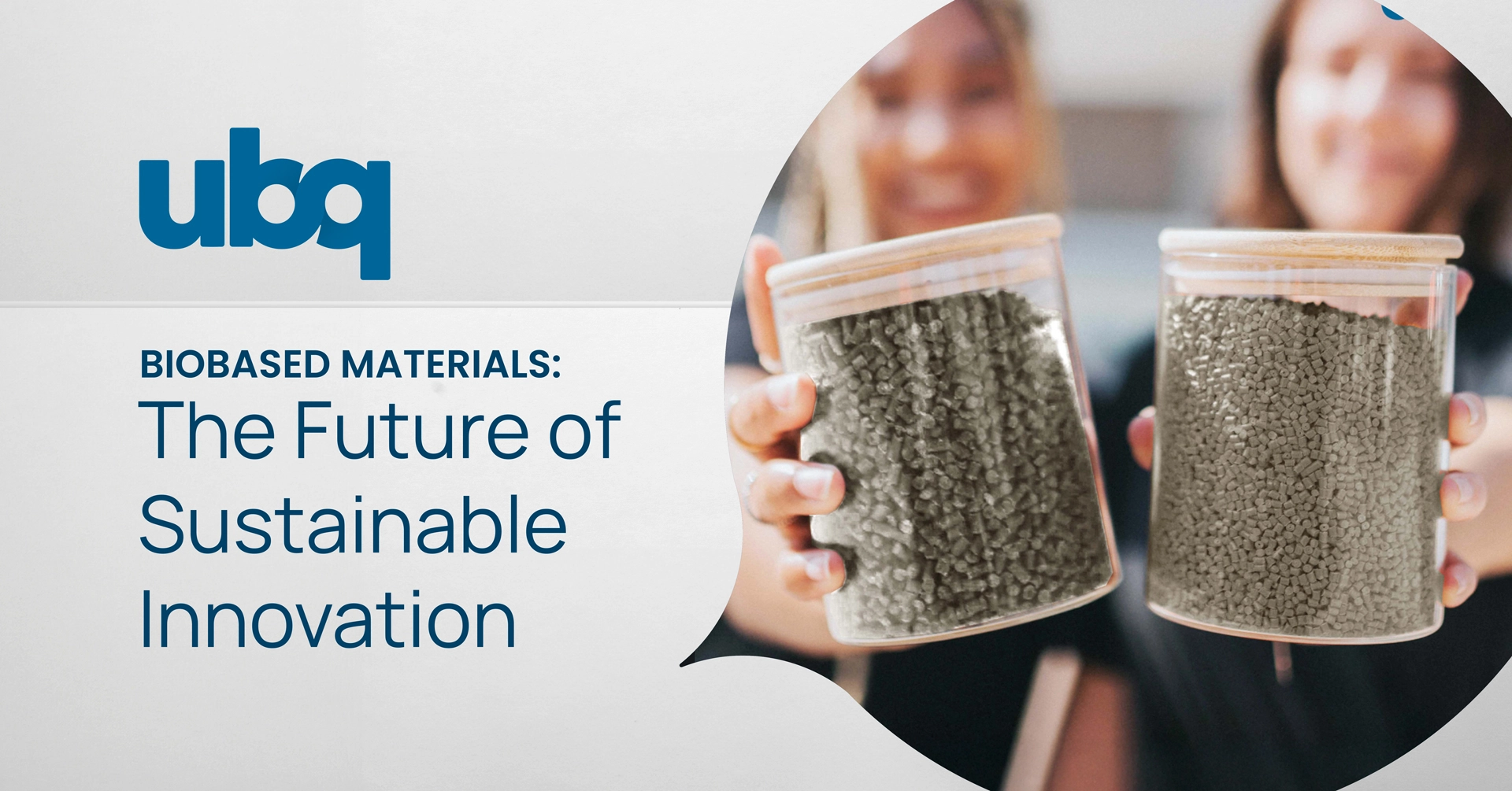The shift towards sustainability demands innovative materials that reduce environmental impact while maintaining performance and economic viability. UBQ™ leads this transformation as a bio-based thermoplastic derived entirely from mixed household waste, including organics and hard-to-recycle materials.
By replacing conventional oil-based resins, UBQ™ provides industries with a sustainable alternative that lowers reliance on fossil fuels, diverts waste from landfills, and reduces carbon footprints. As companies set ambitious sustainability goals, UBQ™ offers a pioneering way to integrate circular economy principles into production.
What Are Bio-Based Materials?
Bio-based materials originate from renewable biological sources such as plants, algae, fungi, and organic waste. Unlike fossil-based materials, they contribute to resource conservation and sustainability. While natural materials like wood and leather fit this category, the focus is now on expanding the portfolio to engineered bio-based materials designed to replace traditional plastics and synthetic substances.
These materials are gaining traction across industries due to their:
- Renewable origins: Sourced from biomass of biological origin instead of petrochemicals.
- Lower carbon footprint: Often reduce greenhouse gas emissions compared to fossil-based materials.
- Biodegradability: Many bio-based materials break down naturally, reducing pollution.
- Resource efficiency: Many bio-based materials require less energy and water to produce compared to conventional materials.
Traditional vs. Bio-Based Sources
Most industrial chemicals today are produced using non-renewable, fossil-based raw materials. In contrast, bio-based materials are created using renewable biomass sources. These sources include:
- Plants and animals
- Forestry materials
- Algae and fungi
- Agricultural and food industry residues (e.g., from sugar refineries, rice processing)
- Agricultural waste
Bio-based materials are not automatically biodegradable, and not all biodegradable materials are bio-based, a key distinction often misunderstood.
Bio-Based Materials in Action
- Bio-based chemicals: Derived from lignin and used in cosmetics, paints, adhesives, and lubricants.
- Biodegradable plastics: Many bio-based plastics return nutrients to the ecosystem through biodegradation.
- Sustainable textiles: Innovations using wood pulp, algae, and plant fibers for eco-friendly fabrics.
- Bio-based composites: Materials like UBQ™ that integrate waste-derived biopolymers into high-performance applications.
Environmental Benefits of Bio-Based Materials
Lower Carbon Footprint
Bio-based materials are derived from renewable biological sources like plants. When substituted for petroleum-based products, they can help reduce greenhouse gas emissions and overall carbon footprints, making them a valuable tool in climate action strategies. Unlike fossil-based materials, they store biogenic carbon absorbed during the source organism’s lifecycle. This carbon storage, especially if maintained in long-lived products or circular business models, further reduces their net carbon footprint.
Climate Change Mitigation
These materials contribute to climate change mitigation by sequestering carbon and offering a renewable alternative to plastics and other high-emission materials. The European Union has acknowledged the role of bio-based materials in reaching climate neutrality by 2050, citing their ability to close carbon loops and reduce reliance on finite resources. Various measures, such as the Global Plastics Treaty and EU regulations, support the use of bio-based materials to meet climate goals.
Resource Efficiency & Circularity
Bio-based products often use agricultural byproducts or organic waste, helping divert materials from landfills and reducing the burden on waste management systems. By doing so, they support a circular economy in which waste is continuously repurposed into new value-added products.
Efficient manufacturing processes are crucial in enhancing the sustainability of bio-based materials, as they can significantly impact energy consumption and overall environmental performance.
Reduced Environmental Impact
Bio-based material production generally involves:
- Lower energy and water use compared to fossil fuel extraction and processing.
- Reduced toxicity, benefiting ecosystems and human health.
- Less dependency on virgin resources, thereby preserving forests, biodiversity, and natural habitats.
The environmental performance of bio-based materials is influenced by various factors, such as resource growth, production circumstances, and manufacturing processes.
Generations of Bio-Based Materials
Bio-based materials sourced from residues and waste (second and third generations) generally offer higher sustainability benefits and lower environmental impacts than those using first-generation feedstocks (crops grown primarily to be used for bio-based materials).
| Generation | Feedstock Sources | Environmental Impact / Benefits / Challenges |
|---|---|---|
| First Generation | Corn, Sugarcane, Soybeans |
|
| Second Generation | Non-food crops (e.g., switchgrass), agricultural and forest residues |
|
| Third Generation | Algae, Whey, Municipal Solid Waste (MSW) |
|
Environmental Considerations
Feedstock Sustainability
When assessing the environmental benefits of bio-based materials, consider:
- Resource inputs (land, energy, water)
- Alternative uses (some agricultural residues may serve ecological functions if left in place)
- Transport emissions (e.g., shipping rice husks long distances increases footprint)
It is also important to evaluate the energy consumption associated with the manufacturing processes of bio-based materials, as it can significantly impact their overall sustainability.
MSW and sewage have been found to be among the most sustainable feedstocks for biofuels and plastics, based on preservation of non-renewables and overall resource efficiency.
End-of-Life Challenges
Not all bio-based materials are biodegradable, and biodegradability does not guarantee environmental benefit.
- Biodegradation requires specific conditions; otherwise, materials may end up in landfills or as litter.
- Mechanical recycling of biodegradable plastics is not widely practiced, and they are often viewed as contamination.
Biodegradable materials might be less likely to be recovered or recycled properly, reducing their overall sustainability. It is important to refer to clear labeling to avoid consumer confusion and promote acceptance of bio-based and biodegradable materials.
UBQ™ as a Third-Generation Bio-Based Material
UBQ™ is an advanced bio-based material made from residual MSW, with over 50% bio-based content. It reflects the best of third-generation bio-based innovation:
- No reliance on or competition with food crops or farmland
- Made from waste that would otherwise be landfilled or incinerated
- Compatible with existing recycling systems
- Engineered for long life and circularity
UBQ demonstrates how third-generation materials can simultaneously tackle waste, reduce emissions, and preserve natural resources.
How UBQ™ Works
UBQ Materials’ patented technology takes mixed municipal waste, including organic and hard-to-recycle materials. Any remnants of metals, minerals, and glass are removed before the process starts. They are sent to be properly recycled.
The remaining organic waste, like banana peels and chicken bones, is used in its entirety and broken into its basic building blocks, including fibers, cellulose, lignin, collagens, and sugars. Inorganic materials (hard-to-recycle plastics) are then bound to this matrix, reconstructing them into a new bio-based thermoplastic composite, UBQ™. The resulting material is a single, patented homogenous composite that can be replicated time and time again.
UBQ Materials’ plant is extremely energy efficient, fully operating on certified green electricity generated by solar or wind power. We have zero operational water consumption, zero effluents, zero combustion, and zero emissions.
UBQ Application Across Industries
UBQ™ is an ideal material to fully or partially replace conventional plastics in durable and semi-durable applications across several industries, including:
- Automotive & Mobility: Used for durable vehicle components, reducing reliance on traditional plastics.
- Building & Construction: Integrated into polymers used in the building and construction industry to lower their carbon footprint and provide more sustainable options. Additionally, UBQ™ can be used in bio-based concrete applications, offering an alternative to traditional concrete.
- Consumer Goods: Replaces conventional plastics in furniture, home goods, tools, garden furniture, and planters.
- Logistics & Supply Chain: Applied to secondary or tertiary packaging such as shipping crates, pallets, and storage boxes.
Challenges & Opportunities in Bio-Based Materials
Challenges
- Higher production costs: Scaling bio-based material production remains a key challenge.
- Market competition: Traditional fossil-based plastics still dominate due to cost efficiency.
- Supply chain adaptation: Businesses require infrastructure adjustments to integrate bio-based materials.
Opportunities
- Regulatory support: Policies promoting sustainable materials encourage adoption.
- Consumer demand: Growing preference for sustainable products drives market expansion.
- Technological advancements: Innovations in bio-based polymers improve performance and cost-effectiveness.
UBQ™ tackles these challenges by offering a cost-competitive, scalable, and pioneering solution for manufacturers looking to integrate bio-based thermoplastic materials into their supply chains.
Case Studies: Real-World Adoption of UBQ™
Mainetti: Sustainable Retail Solutions
Mainetti, a leader in retail solutions, integrates UBQ™ into its hangers, reducing reliance on virgin plastics and cutting carbon emissions.
Consumers play a crucial role in driving the adoption of bio-based materials by demanding transparency and clarity in labeling and branding.
Plastics App™: Low-Carbon 3D Printing
Plastics App™ collaborated with UBQ Materials to create 3D printing filaments with significantly lower environmental impact.
The aggregated knowledge from global researchers and manufacturers plays a crucial role in driving innovation in bio-based materials.
Future of Bio-Based Materials & UBQ™
As the demand for sustainable materials rises, UBQ™ is set to play a crucial role in advancing bio-based innovation. Companies worldwide are looking for alternatives that align with their sustainability targets, and UBQ™ offers a ready-to-use, climate-positive material that transforms waste into endless opportunities. For access to our papers on bio-based materials and other subjects, sign up to our sustainability library.



